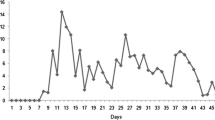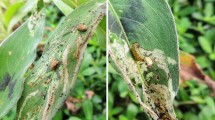Abstract
The Influence of young, mature and senescent leaves of bitter gourd Momordica charantia L. (Cucurbitaceae) on the feeding, growth and reproduction of Epilachna dodecastigma (Weid.) (Coleoptera: Coccinellidae) were studied under laboratory conditions (27 ±0.5 °C, 12 h light: 12 h dark photoperiod, 65 ±5% RH). Larval developmental time of E. dodecastigma was longest on senescent leaves followed by young and mature leaves, whereas the pupal period was shortest on young and mature leaves. The longevity of females was generally higher than males. Male and female longevity were highest on mature leaves and lowest on senescent leaves. Fecundity was highest on mature leaves followed by young and senescent leaves. The growth and development of E. dodecastigma were related with nutrient and phenol content of three types of bitter gourd leaves. Carbohydrate content was higher in young and mature leaves, whereas protein, nitrogen, amino acid and lipid content were in greater quantities in mature leaves followed by young and senescent leaves. Phenol content was greatest in senescent leaves and least in mature leaves. Higher level of carbohydrates, proteins, lipids, nitrogen and amino acids including water content and lower phenol content of mature leaves had Influenced higher growth rate and fecundity of E. dodecastigma.
Similar content being viewed by others
References
Applebaum S. W. (1985) Biochemistry of digestion, pp. 279–312. In Comprehensive Insect Physiology, Biochemistry and Pharmacology (edited by G. A. Kerkut and L. I. Gilbert). Pergamon Press, Oxford, England.
Awmack C. S. and Leather S. R. (2002) Host plant quality and fecundity in herbivorous insects. Annual Review of Entomology 47, 817–844.
Bray H. G. and Thorpe W. V. (1954) Analysis of phenolic compounds of interest in metabolism. Methods of Biochemical Analysis 1, 27–52.
Choudhuri D. K., Mondal S. and Ghosh B. (1983) Insect pest and host plant interaction: The Influence of host plant on the bionomics of Epilachna dodecastigma (Coleoptera: Coccinellidae). Comparative Physiology and Ecology 8, 150–154.
Dadd R. H. (1985) Nutrition: Organisms, pp. 313–390. In Comprehensive Insect Physiology, Biochemistry and Pharmacology (edited by G. A. Kerkut and L. I. Gilbert). Pergamon Press, Oxford, England.
Downer R. G. H. and Matthews J. R. (1976) Patterns of lipid distribution and utilisation in insects. American Zoologist 16, 733–745.
Dubois M., Gilles K. A., Hamilton J. K., Rebers P. A. and Smith F. (1958) Colorimetric determination of sugars and related substances. Analytical Chemistry 28, 351–356.
Folch J., Lees M. and Sloane-Stanley G. H. (1957) Asimple method for the isolation and purification of total lipids from animal tissues. The Journal of Biological Chemistry 226, 497–509.
Harborne J. B. (2003) Introduction to Ecological Biochemistry, 4th edn. Academic Press, San Diego, California. 384 pp.
Hossain M. S., Khan A. B., Haque M. A., Mannan M. A. and Dash C. K. (2009) Effect of different host plants on growth and development of epilachna beetle. Bangladesh Journal of Agricultural Research 34, 403–410.
Jeyabalan D. and Murugan K. (1996) The impact of variation in foliar constituents of Mangifera indica Linn. on consumption and digestion efficiency of Latoia lepida Cramer. Indian Journal of Experimental Biology 34, 472–474.
Khan M. H., Islam B. N., Rahman A. K. M. M. and Rahman M. L. (2000) Life table and the rate of food consumption of epilachna beetle, Epilachna dodecastigma (Wied.) on different host plant species in laboratory condition. Bangladesh Journal of Entomology 10, 63–70.
Lowry O. H., Rose Brough N. J., Farr A. L. and Randall R. J. (1951) Protein measurement with the folin phenol reagent. The Journal of Biological Chemistry 183, 265–275.
Mattson W. J. (1980) Herbivory in relation to plant nitrogen content. Annual Review of Ecology and Systematics 11, 119–161.
Mattson W. J. and Scriber J. M. (1987) Nutritional ecology of insect folivores of woody plants: Nitrogen, water, fiber and mineral considerations, pp. 105–146. In Nutritional Ecology of Insects, Mites, Spiders and Related Invertebrates (edited by F. Slansky and J. G. Rodriguez). Wiley, New York, USA.
Moore S. and Stein W. H. (1948) Photometric ninhydrin method for use in the chromatography of amino acids. Journal of Biological Chemistry 176, 367–388.
Nation J. L. Sr (2001) Insect Physiology and Biochemistry, 3rd edn. CRC Press, Boca Raton, Florida, 485 pp.
Ramakrishna N., Sannappa B. and Govindan R. (2003) Influence of castor varieties on rearing and grainage performance of different breeds of eri silkworm, Samia cynthia ricini. Journal of Ecology 15, 279–285.
Roy N. and Barik A. (2012) The impact of variation in foliar constituents of sunflower on development and reproduction of Diacrisia casignetum Kollar (Lepidoptera: Arctiidae). Psyche avail Volume 2012 (2012), Article ID 812091, 9 pages. doi:10.1155/2012/812091.
Roy N. and Barik A. (2013) Influence of four host-plants on feeding, growth and reproduction of Diacrisia casignetum (Lepidoptera: Arctiidae). Entomological Science 16, 112–118. doi:10.111/j.1479-8298.2012.00546.x.
Roy N., Laskar S. and Barik A. (2013) Amino acids through developmental stages of sunflower leaves. Acta Botanica Croatia 72, 23–33. doi: 10.2478/v10184-012-0009-5.
Sarkar N., Mukherjee A. and Barik A. (2013a) Long-chain alkanes: Allelochemicals for host location by the insect pest, Epilachna dodecastigma (Coleoptera: Coccinellidae). Applied Entomology and Zoology 48, 171–179.
Sarkar N., Mukherjee A. and Barik A. (2013b) Olfactory responses of Epilachna dodecastigma (Coleptera: Coccinellidae) to long-chain fatty acids from Mom-ordica charantia leaves. Arthropod-Plant Interactions 7, 339–348.
Sarkar N., Mukherjee A. and Barik A. (2015) Attraction of Epilachna dodecastigma (Coleoptera: Coccinellidae) to Momordica charantia (Cucurbitaceae) leaf volatiles. Canadian Entomologist 147, 169–180.
Schoonhoven L. M., van Loon J. J. A. and Dicke M. (2005) Insect-Plant Biology. Oxford University Press, Oxford. 421 pp.
Scriber J. M. (1977) Limiting effect of low leaf-water content on the nitrogen utilization, energy budget and larval growth of Hyalophora cecropia (Lepidoptera: Saturniidae). Oecologia 28, 269–287.
Scriber J. M. (1984) Host-plant suitability, pp. 159–202. In Chemical Ecology of Insects (edited by W. J. Bell and R. T. Carde). Chapman and Hall, New York, USA.
Shobana K., Murugan A. and Naresh Kumar A. (2010) Influence of host plants on feeding, growth and reproduction of Papilio polytes (The common mormon). Journal of Insect Physiology 56, 1065–1070.
Slansky F. Jr. and Scriber J. M. (1985) Food consumption and utilisation, pp. 87–113. In Comprehensive Insect Physiology, Biochemistry and Pharmacology (edited by G. Kerkut and L. I. Gilbert). Pergamon Press, Oxford, England.
Vogel A. I. (1958) Elementary Practical Organic Chemistry, Part III. Quantitative Organic Analysis. Longman Group Limited, London. 840 pp.
Waldbauer G. P. (1968) The consumption and utilization of food by insects. Advances in Insect Physiology 5, 229–289.
Zar J. H. (1999) Biostatistical Analysis. Pearson Education Inc., New Delhi, India, 663 pp.
Author information
Authors and Affiliations
Corresponding author
Electronic supplementary material
42690_2019_3604195_MOESM1_ESM.docx
Effect of bitter gourd (Cucurbitaceae) foliar constituents on development and reproduction of Epilachna dodecastigma (Weid.) (Coleoptera: Coccinellidae)
Rights and permissions
About this article
Cite this article
Sarkar, N., Mukherjee, A. & Barik, A. Effect of bitter gourd (Cucurbitaceae) foliar constituents on development and reproduction of Epilachna dodecastigma (Coleoptera: Coccinellidae). Int J Trop Insect Sci 36, 195–203 (2016). https://doi.org/10.1017/S1742758416000199
Accepted:
Published:
Issue Date:
DOI: https://doi.org/10.1017/S1742758416000199




